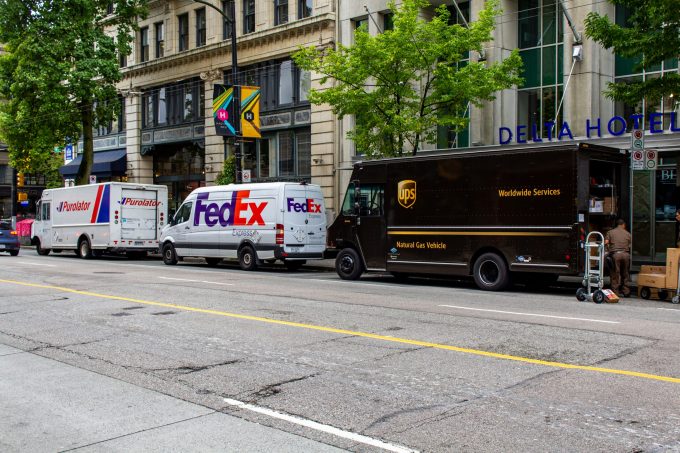UPS drama – a Premium back and forth on key bits and pieces
Network power
TFII: SOLID AS USUALMAERSK: WEAKENINGF: FALLING OFF A CLIFFAAPL: 'BOTTLENECK IN MAINLAND CHINA'AAPL: CHINA TRENDSDHL: GROWTH CAPEXR: ANOTHER SOLID DELIVERYMFT: HERE COMES THE FALLDSV: LOOK AT SCHENKER PERFORMANCEUPS: A WAVE OF DOWNGRADES DSV: BARGAIN BINKNX: EARNINGS OUTODFL: RISING AND FALLING AND THEN RISING
TFII: SOLID AS USUALMAERSK: WEAKENINGF: FALLING OFF A CLIFFAAPL: 'BOTTLENECK IN MAINLAND CHINA'AAPL: CHINA TRENDSDHL: GROWTH CAPEXR: ANOTHER SOLID DELIVERYMFT: HERE COMES THE FALLDSV: LOOK AT SCHENKER PERFORMANCEUPS: A WAVE OF DOWNGRADES DSV: BARGAIN BINKNX: EARNINGS OUTODFL: RISING AND FALLING AND THEN RISING

The vultures are circling over the looming contract negotiations between UPS and the Teamsters union.
Competitors are nudging UPS customers to shift parcel volume over to them as a protection policy for a possible strike this summer.
The five-year contract for some 340,000 UPS employees who are Teamsters members is going to expire on 31 July. Negotiations for the new contract are set to get under way next month, but the union has signalled that it intends to take a tough stance.
Its leadership has called the current contract flawed and promised to push for higher wages for part-time employees and eliminate a controversial two-tier wage system.
FedEx has targeted UPS customers with a message urging them to shift traffic over. Letters and e-mails sent by FedEx to these firms point out that no provider has enough capacity to absorb the volumes that would be stranded if UPS were paralysed by a strike.
FedEx is pushing shippers to make the transition before April, claiming volumes taken on by 31 March would be included in the company’s capacity planning for the summer, so shippers who make the shift early will be guaranteed that their traffic moves. Business brought in after 31 March will be treated on a first-come, first-served basis, FedEx warned, urging shippers: “Don’t wait until it’s too late.”
The integrator needs early commitments to facilitate its capacity planning. In response to its dismal results last summer as volumes slumped, FedEx has embarked on a drastic cost reduction programme that has seen over 12,000 lay-offs, routes cut and aircraft grounded.
FedEx needs volume and revenue, noted LPF Spend Management in a blog post commenting on the integrator’s customer-fishing drive. It had started chasing UPS customers in early January, with warnings about capacity bottlenecks in the event of a strike in the summer, urging them to commit early, said John Haber, chief strategy officer of Transportation Insight.
“Everybody is leveraging this,” he added.
The prospect of a strike is a concern. Older customers recall a strike at UPS in 1997 that lasted for 15 days, and the seemingly endless contract stand-off between west coast longshoremen and employers has prompted shippers to divert traffic away from west coast ports.
“The situation is certainly creating anxiety for shippers,” Mr Haber said. “We tell our customers that they can’t have all their eggs in one basket.”
A strike at UPS would trap a large volume of Amazon traffic that would have to compete for alternative carriage. Last year, UPS moved 1.3 billion parcels for the e-commerce behemoth, which accounted for 11.3% of the integrator’s revenue. The two sides are bent on reducing the collaboration, but this only fell last year from 1.41 billion parcels in 2021.
Amazon itself has shuttered or postponed warehouses, laid-off staff and is not renewing aircraft leases, which suggests that there will not be a huge shift in traffic from UPS into its own network in the coming months.
Regional parcel carriers have limited capacity to pick up volumes from UPS customers. Moreover, they do not cover the international arena, Mr Haber noted. Moreover, some of those players have signalled that they don’t want to be a stopgap for a UPS strike – although they would welcome longer-term deals.
Mr Haber said many UPS customers were more or less stuck with the company and would face penalties if they moved volume away or did not hit certain levels of traffic.
UPS CEO Carol Tomé has expressed confidence that her company and the union can come to an agreement before the deadline that brings a win for employees, the company and its customers.
That said, UPS managers are not eligible for paid leave this July and August so they can be available to move parcels if needed.
Comment on this article